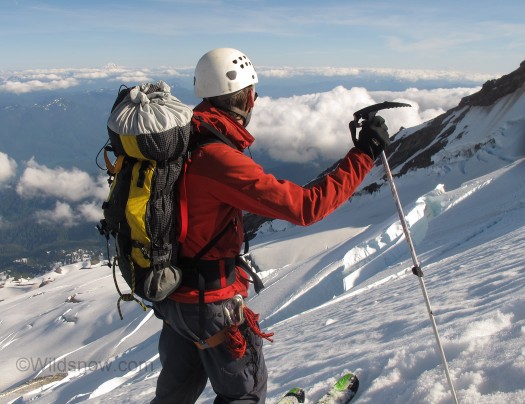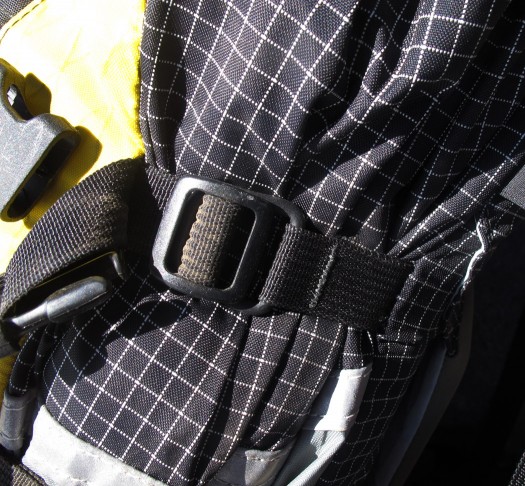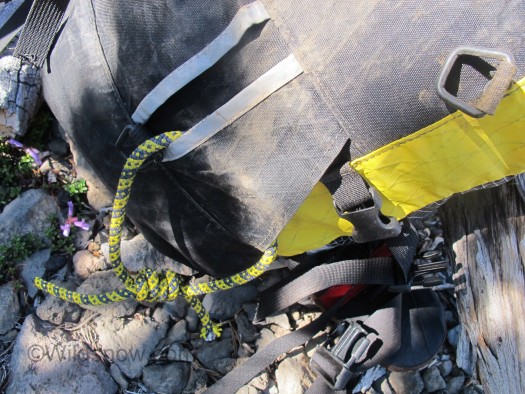A light pack is an excellent way to reduce weight while not sacrificing much safety or utility. Cilogear is perfect for this, as they make simple, light backpacks that are well designed and last forever. As a bonus, Cilogear rucks are hand made in Portland, resulting in enhanced customer service and quality controlled workmanship.
The first Cilogear pack I used was their cavernous 75 liter WorkSack. It worked great for Denali, and a few other trips as well. While 75 liters in name, the 75 is considerably bigger when taking into account the expansion collar, hence it is too huge for anything but a multiday trip with tons of gear. Of the packs I own, the next size down is 35 liters. That’s great for day trips, and I’ve made it work for several overnights, but for a while I’ve been feeling the need for a slightly bigger pack in the 40-50 liter range that’ll be easier to pack for overnights but also work well as an alpine day-pack.
Since I liked the 75 liter WorkSack so much, I decided to try out the 45 model. Cilogear’s worksacks are intended for climbing, rather than ski mountaineering, but this results in a light, durable pack which is exactly what I want for spring skiing.
All Cilogear’s WorkSacks are similar in design, and use many of the same features They have figured out a formula that works well, and apply it to a wide range of pack sizes, from 20 liters all the way to 75. The 45 lacks the crampon pouch found on other Cilogear packs, and also has lighter fabric on some sections. A few other small changes make the 45 very light, in fact lighter than the 40 liter, which has more features.
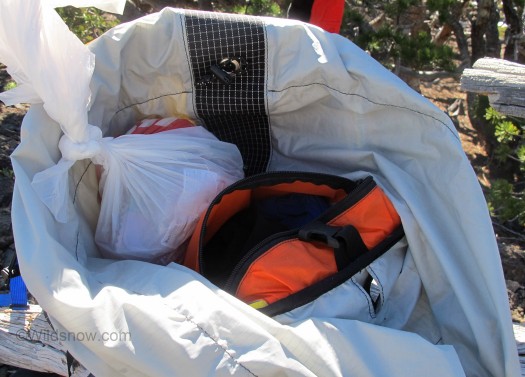
The Cilogear 45 is a traditional top loader design with a lid, consisting of one large main compartment, one small interior pocket, and two pockets in the lid. I don’t like packs that have too many pockets, both for weight considerations and the fact that I tend to lose stuff if I have a arsenal of pockets to root through. The 45 has a nice balance of pockets, allowing for easy organization. The “ninja pocket” in the interior of the pack is great for keeping stuff that is small and you need to be able to find quickly, but also won’t need throughout the day, such as a headlamp and repair kit. I keep my food and miscellaneous smaller items in the lid for easy access. The pack of course lacks a shovel pocket, so it is a little awkward storing a shovel blade inside. However it is manageable, and on many spring and summer ski trips I leave the shovel at home. Cilogear does make a shovel pocket that clips to the outside of the pack, although I haven’t had a chance to try it.
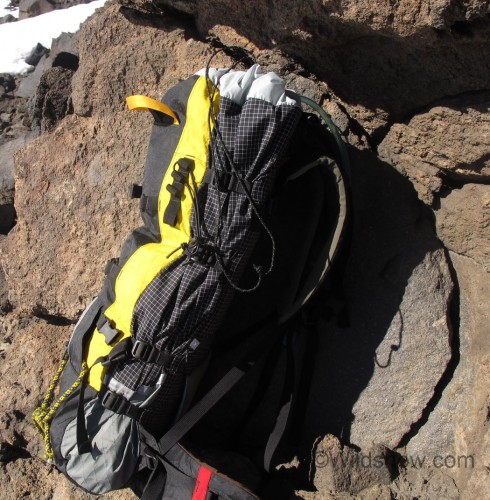
The 45 liter WorkSack with both sides compressed and with the lid removed, just the right size for some runs on Mount Adams, Washington.
The genius of the Cilogear packs is their versatility. Nearly everything can be removed, transforming the pack to a simple sack with straps, a full-on load carrying machine, or anything in between. This does take a little experimentation, and I am still trying different configurations for different trips. For skiing I like my pack to be compact and not flop around, so I while I could leave some of the exterior straps at home, I’ve kept them on the pack for many of my trips.
During a day-trip I did take the hard plastic frame out. Doing so worked well until I put my skis and boots on the outside of the pack. After that the extra weight and leverage made it quite uncomfortable as the sack gradually compressed and curved throughout the day without something inside to stiffen it vertically.
The 45 can be compressed into almost any conceivable volume. For day trips without much gear I have been compressing both sides fully, and storing the lid inside the pack, reducing volume to something like 20 liters.
With all the straps and the frame in the Cilogear 45, it carries loads amazingly well. It has basically the same suspension system as the 75 liter pack, and it shows. I’ve had the 45 fully loaded with 2 liters of water and skis and boots, and it felt fantastic. I would however prefer the foam in the shoulder straps to be a little stiffer, as they appear to be softer compared to the 75. Even with its awesome load carrying capabilities the system is light and simple. It consists of a single aluminum stay attached to a sheet of HDPE, a 1/4 inch foam pad folded in two, and some well placed straps.
The 1/4 inch bivy pad is a great feature, one that in my opinion should be included in every pack in existence. I pull it out all the time during the day to sit or stand on, and also use it as extra insulation when I’m sleeping. I hope to never use it in an unplanned bivy, but it would be better than nothing. It’s also nice to have a bit of potentially sacrificial closed cell foam on hand, considering the number of times I’ve forgotten my insoles on ski trips over the years.
None of the Cilogear packs are purpose designed to carry skis diagonally, but I find it necessary to modify most packs that do have a so-called ski carry system, so the lack of a factory system on the Cilogear is not a big deal to me. While it’s easy for us skiers to criticize Cilogear for not providing this feature, know that one of the goals of Cilogear design is versatility, and a decent diagonal ski carrying rig can be cobbled from the straps that come with the pack when you buy it. I’d suggest we not obsess on the lack of this feature. After all, if you’re a backcountry person you should have at least a modicum of skill with knots, straps and thinking through things like attaching a ski to a backpack. Otherwise, you should be at a ski resort where you can hire a ski concierge!
To rig my version of diagonal carry on the Cilogear Worksack 45, I tie an old piece of 6 mil cord near the base of rucksack, and simply loop a ski strap through one of the top Dee-clips. Rigged like that, the 45 carries skis as well as any other pack I’ve tried. I was a little worried about the durability of where I attached the cord, but it’s holding up. When I’m carrying boots as well, I use a A-frame system for the skis with boots clipped in. This works well with the compression straps on the side of the pack.
Beyond having to spend 5 minutes and tie a ski loop onto the pack, there isn’t really much to complain about with the 45 liter WorkSack. I do think it would be great if they offered a few more options for hipbelts. The belt that comes with the pack is wide and stiff, great for carrying loads, but a bit overkill for lighter days. I like a minimal hipbelt most of the time, as it is lighter and works better with a harness. The hipbelts on Cilogear packs are removable, so you can go with out them to reduce weight. It isn’t really practical to not have a hipbelt while skiing, but it would be great if Cilogear made a few other options for waistbelts that could be attached to their packs. I’d love to have some pockets on the hipbelt as well.
Another feature of the Worksack 45 (and most other Cilogear rucksacks) that works super is the ice axe carry system. This doesn’t use the classic “loop” system that packs have been using for generations. Instead, it comprises two fabric sleeves that hold the pick of the axe, and then a buckle and a piece of shock cord that hold the shaft. One terrific aspect of this system is it allows you slide out the ice axe easily, as opposed to the traditional “loop” system, which requires you to flip the axe 180 degrees. This really shines when you have to access your axe on steep slopes. I’ve carried technical ice tools, normal ice axes, and whippets on the system, and it holds them all securely.
In all, if you want to save weight and have a backpack with super versatility, consider Cilogear.
Cilogear 45 Liter Worksack stats: Pack Bag: 790g / 27 oz. Hipbelt: 120g / 5 oz. Lid: 170g / 6 oz. Full Strap Kit: 160g / 6oz Framesheet + Pad: 550g / 19 oz. Max Weight 1.8kg / 3.9lbs.
Direct link to CiloGear description of their 45 Liter rucksack.
Louie Dawson earned his Bachelor Degree in Industrial Design from Western Washington University in 2014. When he’s not skiing Mount Baker or somewhere equally as snowy, he’s thinking about new products to make ski mountaineering more fun and safe.

